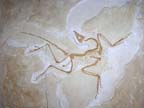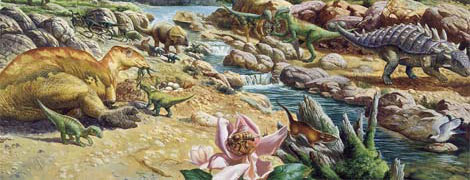 |
 |
 |
 |
 |
Produced
by the Population Genetics and Evolution class, Furman University |
||||
 |
 |
 |
 |
 |
Produced
by the Population Genetics and Evolution class, Furman University |
||||
 |
The
Cretaceous: Microraptors |
 |
||
| Microraptors
were a group of very small four-winged dromeaosaurid dinosaurs, representing
an intermediary stage between the evolution of birds and dinosaurs. They
are the smallest recorded dinosaurs measuring about 39 cm in length, with
about 24 cm of that belonging to their tail (Hecht 2000). They had a combination
of unserrated and partially serrated teeth, a constricted waist, and long
upper arm bones, all shared characteristics between primitive birds and
troodontids. The feathers were fully formed on all four legs, and there
was a feather fringe on the tail. They were fast running two-legged dinosaurs,
with feet structured for the grasping of branches, suggesting they may
have been arboreal. This arboreal lifestyle could further explain the
flight adaptation, likely developing from gliding behavior between trees
(Mayell 2003). There is a debate among scientists as to whether flight
evolved in a “ground up” or “tree down” manner.
But the discovery of this four winged animal supports the idea that they
adapted to gliding rather than running for velocity, since the feathers
on the back of their legs would be a hindrance to their running ability.
However, “ground up” proponents suggest that the feathers
were positioned in such a way to avoid interference. However when glide
tests were performed on 3D models of microraptors the “ground up”
flight method was found to require an anatomically unlikely head for balance
(Ruben 2010). Page by Megan Aprill |
 |
| Image of a microraptor, from: The Other Journal | |
|
Hecht J. 2000. Micro-raptor. New Scientist. Accessed April 5, 2010. Mayell H. 2003. Four Winged Dinosaurs Found in China, Experts Announce. National Geographic. Accessed April 5, 2010. Ruben J. 2010. Paleobiology and the origins of avian flight. P Natl Acad Sci USA 107:2733-2734. Accessed April 5, 2010. Wikipedia. 2010. Microraptor. Accessed April 5, 2010. |